
Knee Walker
Product Guide and Recommendations
A knee walker is a specialized mobility product for the elderly commonly used by seniors who cannot put weight on their foot or leg due to a fracture or surgery.
Doctor's often want patients who have had a fracture or surgery of their foot/leg not to place any weight on that foot/leg for 8-10 weeks. This gives the body time to heal properly.
Without this type of device the elderly would need to use crutches, a folding walker and/or a wheelchair. These types of mobility aids can be difficult and cumbersome.
A knee walker can allow elderly to be more independent and more active.
They can literally scoot around on one - pushing with their "good" leg while their "bad" leg is supported by the walker.
However, it is not the best solution for all elderly. Seniors need to have good balance, strength and coordination to safely use this type of walker.
Overview
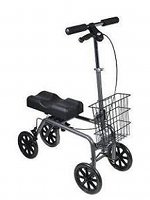
A knee walker is a mobility product for the elderly who need to keep weight off their lower leg and/or foot due to a surgery or fracture.
It is an alternative to crutches, a folding walker and/or a light weight wheelchair which can be inconvenient and difficult for some seniors to use.
As you can see in the photo, it has wheels, a handlebar, brakes and a place to support the injured leg. It almost looks like a kids scooter and it works much the same way!
The senior pushes with their "good" leg, steers with their hands and the walker supports the "bad" leg.
However, it's only a great alternative for seniors with good balance, strength and coordination.
Who Should Use?
A knee walker is a great alternative to crutches for elderly who have good balance, strength and coordination.
Some elderly (as well as those much younger!) simply cannot use crutches efficiently and do not have the strength to use a folding walker.
This type of walker may allow them to be independent and safe at the same time.
It is not intended to replace different types of walkers designed to prevent falls by supporting seniors with balance, strength and endurance issues.
Who Should NOT Use?
Elderly who do not have good balance, strength or coordination will have difficulty safely using a knee walker.
They should consider using a folding walker and/or a wheelchair.
Doctor's typically want their patients to stay off their affected leg for 2-3 months to allow proper healing so it's best to be patient, play it safe and prevent further injury.
Elderly who are looking for a walker because they have balance, strength and endurance issues should consider different walkers for elderly.
For more information: Mobility Products for the Elderly.
Recommended Features
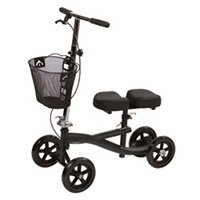
A good knee walker will have the following features:
- Hand brakes - For safety and ease of use.
- Steerable - This style is easier to use than non steerable models.
- Foldable - For easy transport in a car or truck.
- Four wheels - Are sturdier than the three wheeled models.
- Comfortable leg support - Needs to be well padded and comfortable.
- Basket/bag - As the senior's hands will be busy while moving.
- Larger wheels - At least 8" in diameter so that it will easily roll over uneven ground (ex. gravel/sand on sidewalks).
- Lightweight - Will be easier for the senior to use.
- Adjustable height - Both the handles and support for leg.
- Weight capacity - Make sure the knee walker is designed for the senior's weight.
Accessories
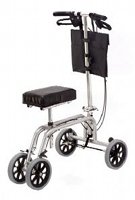
There are a number of accessories including:
- Bags/basket - For small items while shopping, etc.
- Different handles - Even some types of bike grips will fit on the handlebars making it more comfortable.
- Knee pad/leg support cover - Providing more comfort, style and can be washed to keep clean.
For more information: Walker Accessories
How to Fit
They should be fit properly before using. It's important to know two measurements to get the proper leg support and handle heights.
How to measure:
- Have the senior wear their regular shoes
- Have them stand near a chair or wall for balance
- Measure from the ground to the middle of their knee cap - this measurement is for the leg support height
- Have them put one arm by their side
- Measure from the ground to the crease of their wrist - this measurement is for the handlebar height
A proper fit will allow the senior to stand tall with their knee/lower leg on the leg support, hips level (not leaning to one side) and hands on the handlebars.
How to Use
They are similar to use as a kid's scooter. The senior rests their affected leg on the leg support, holds onto the handles and pushes themselves with their "good" leg.
Proper use:
- Adjust for proper fit
- Put the brakes on
- Place the affected knee on the leg support
- Release brakes and push with unaffected leg
- Use brakes to control speed
- Steer with handlebars
- Be careful of balance when cornering.
For models that do not have steering, the senior will need to pick the front of the walker up slightly to turn.
How Much Do They Cost?
Knee walkers can cost $350-500 depending on the quality and features.
Since they are typically only needed for 2-3 months at a time, some stores rent them.
Other Types of Walkers
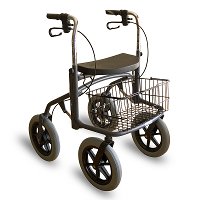
There are a number of different walkers available, each with their own purpose.
- Folding walker - Sturdy walker used for people who need to keep weight off a foot/leg.
- Front wheel walker - Similar to a folding walker but with 2 wheels and 2 standard legs.
- Rollator walker - Four wheeled walker with a bag/basket, hand brakes and a seat.
- 3 wheel walkers - Similar to a rollator except only has 3 wheels and no seat.
- U-Step walker - Specialized wheeled walker designed for elderly with Neurological conditions such as Parkinson's Disease
Return to Mobility Products for the Elderly
Return to Caring for Aging Parents


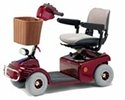



New! Comments
Have your say about what you just read! Leave me a comment in the box below.